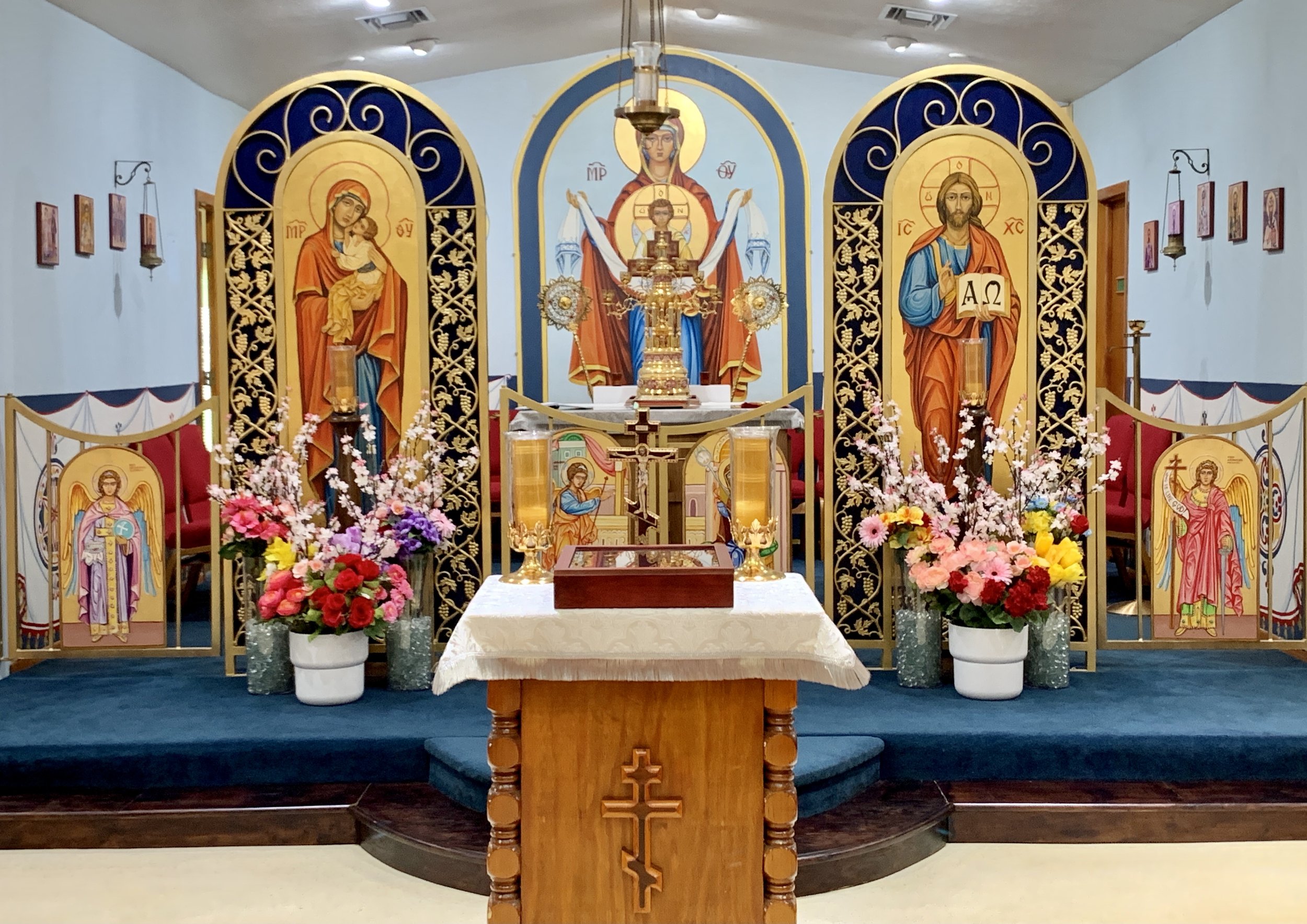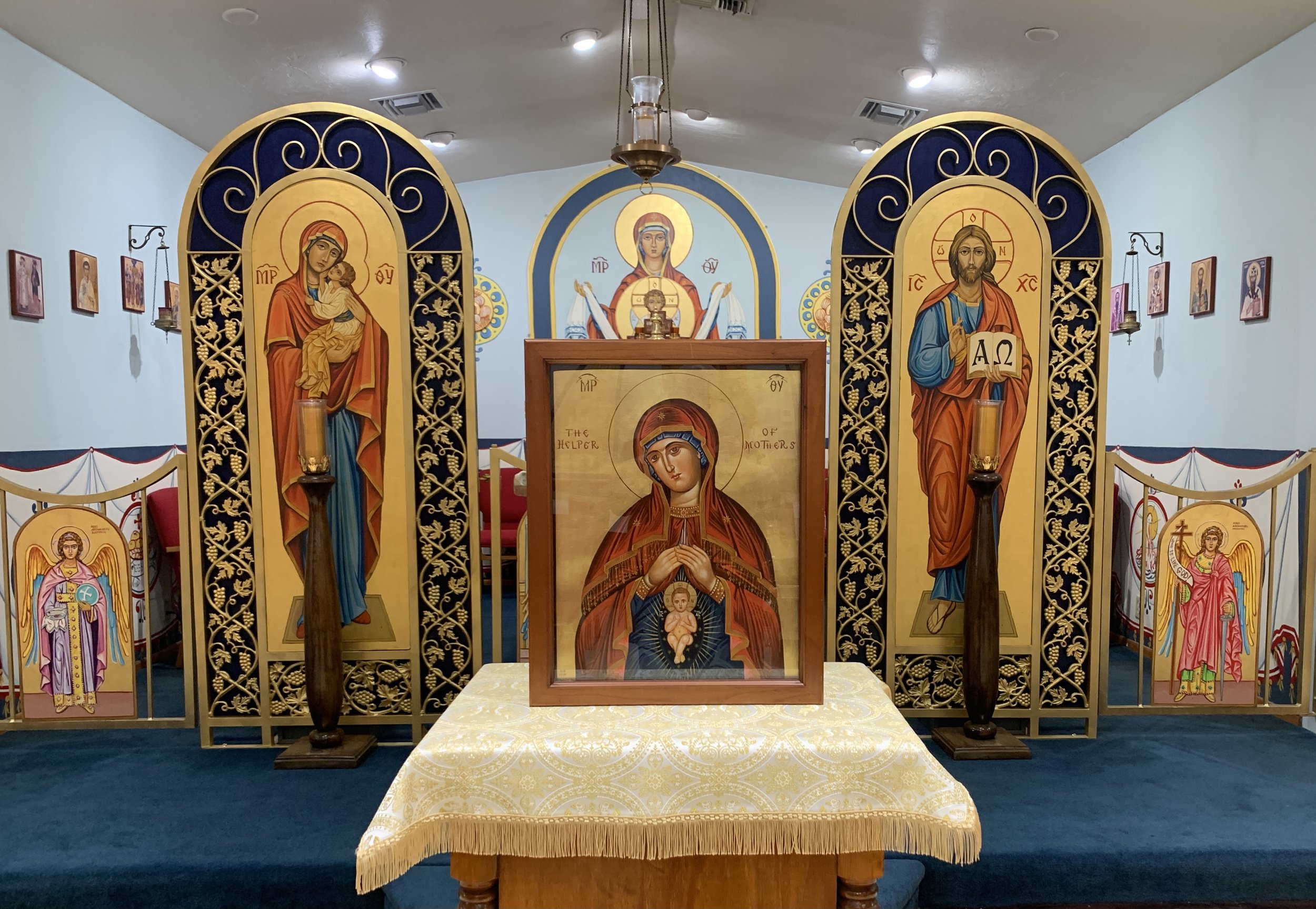Welcome to All Saints Byzantine Catholic Church Iconography Page
As you walk into the church, you will begin to see the beautiful Icons that are on the walls and even the ceiling too. This page will provide you with information about iconography, an explanation of the Icons that you will find inside the parish, and about the interior of the church. We hope you find this information helpful as you come to know All Saints and the beautiful gift in which we have received. It is this very gift: the faith, the parish, the dependence on God, and the necessity of a deep intimate relationship with Him, that we must pass on to the next generations.
As you enter through the doors of the parish of All Saints, you will see Icons of various Feast Days from the lives of Jesus and Mary. The walls are filled with various Icons that each tell a story within the Icon itself. You are invited to explore and journey with us as we look at the iconography within the church and to learn about the interior of the church.
Before we begin our journey, let’s learn about the interior structure of a Byzantine Catholic Church as you will find and see at All Saints Byzantine Catholic Church.
As you walk into the parish, you might notice a large chandelier and an Icon of Christ on the ceiling. The Icon on the ceiling is called Christ the Pantocrator, or Christ Pantocrator which means, Christ the Ruler or Christ Ruler of the Universe. It can also mean Christ All-Powerful or Christ the Almighty too. This Icon is usually found on the inside of the central church dome, if the central dome is able to be seen within the interior of the church. At All Saints, the Icon is roughly where the central dome is located and symbolizes and shows us of the reality of Christ being in the heavens and is the ruler of all of creation.
As you walk forward or follow with your eyes, from the Pantocrator straight ahead you will arrive at the Royal Doors. Behind the Veil, which represents the Temple Veil torn in two after the death of Jesus, you will find the tabernacle that contains our Lord, God and Savior Jesus Christ. The idea is that as you walk into the parish arriving at the back of the center aisle. As you look first at the Icon of Christ the Pentocrator and then continue looking towards the Iconscreen, your vision leads you from the Heavenly, represented by the Pantocrator Icon, to the earthly, the Eucharist, reserved in the tabernacle. Jesus is truly in the heavens and on earth.
The view in this picture, allows you to see what it would look like as you came from the front door, as you moved towards the center aisle when you walk into the parish. The picture was taken during the time of the Nativity or Christmas time. This provides you with a little taste of what you will see during the Pre-Christmas Season and during the Christmas Season too.
This is additional view from the opposite side of the previous picture. At All Saints, we have four sections of seats in which the faithful are invited to worship from. Each section and row has a unique location and provides you with different views from each section and row. Some of the family members tend to stay in one particular section and others like to move around. The best part about all of this, is that there is no assigned seating, and not one person takes another person’s spot. Rather, any of the faithful, family members or visitors can sit where they desire as they arrive to the parish on the day of the Divine Service.
Inside All Saints church, you will see a red carpet in the center aisle that leads up to this table that you see before you. The table is called a tetrapod or four legged table. The tetrapod is common to all Byzantine Churches and usually has two candles, a crucifix or cross, and an Icon. The Icon is either of a particular saint, feast day, or the patron saint or feast day of the parish. The Icon is located in the shadowbox that you see before you. The Patronal Icon of All Saints is well, you guessed it, All Saints. Our particular version of the Icon is called All Saints Divine Chorus.
One question you might be wondering about as we begin our journey is, what is an Icon? Let’s find out together the answer first before we move on to the Icons in the Church.
Icons have long been considered windows into heaven. The goal of an iconographer when they begin and end their work on an icon, is to allow those who pray before it to be taken up into heaven by God in their prayer time in front of an icon
God reveals Himself through an icon in various ways for each person who prays with a particular icon. The icon itself is not an idol nor does it claim to be. Rather, it provides a way for the faithful to connect to the Divine in their prayer time with the Lord through praying before an icon.
The Icon below is the Patronal Icon of the parish, All Saints Byzantine Catholic Church. One of the reasons this is our Patronal Icon, before we get to the nitty gritty of the Icon itself, is because of our full, or as much as we can, participation in the Divine Services. We love to sing, it might be a little loud, proud, and even sometimes a bit off key too. Although it may not be perfect, it is a true representation of how our God calls the imperfect to Himself, and transforms the imperfect into a beautiful gift, which is the Divine Worship that God has invited us to participate in.
Remember, we are not doing God a favor by coming to the Divine Services, rather, it is God who invites us to receive and participate in the gift of worshiping God. This parish is a gift in which we desire to cherish and pass on the gift of this parish and faith to the many generations who come after us.
Diving into the Meaning of the Icon of All Saints Divine Chorus
As you can see, Christ is at the center of the Icon and to the right of Him is John the Forerunner and on the left side of Jesus, Mary the Theotokos, both are standing in supplication (asking or praying for an intention to Jesus). The entire Icon with the grass and trees is depicting the heavenly paradise that is awaiting us when we pass from this life to the next. The heavenly gift of eternal life that we have the opportunity to receive as we follow Jesus and draw closer to Him though our relationship with Him and our responses to God’s invitations.
Within the large circle, representing all creation including light and darkness seen through the images of the sun and moon, you will see the numerous choirs of angels and saints that surround Jesus. These would be considered the “cloud of witnesses” that Saint Paul talks about in his letter to the Hebrews. They are lined up according to rank, such as angels, archangels, ascetics, fathers, forefathers and so on. You might notice the empty throne on the bottom center of the circle. That is Christ’s Throne, one giveaway that this throne belongs to Christ is because the gospel book is on the throne along with royal garments, to remind us of His second coming. The male and female that are on either side of the throne are Adam and Eve.
Let us turn our attention to the outside of the circle. Two people on the top of the Icon outside of the circle are King David located on the left side and King Solomon on the right side.
Next, we will look at the bottom of the Icon outside the large circle. In the bottom left corner of the Icon outside of the circle, we see Abraham holding a righteous soul. Many icons will depict a righteous soul by using a small baby to represent the righteous soul. Speaking of Abraham, Abraham reminds us of what we pray for when are praying for our departed brothers and sisters. One of the prayers for the deceased talks about asking God to place the soul of His departed servant in the bosom of Abraham, Isaac and Jacob.
Turning our attention to the bottom right corner of the Icon outside of the circle, we see Jacob holding the twelve tribes of Israel. The bottom center outside of the circle is the repentant thief. The thief on the right side of Jesus who asked Jesus to remember him when Jesus comes into His Kingdom. Another name for the repentant thief is also called the Good Thief, because he asked for forgiveness of his sins prior to his death on the cross.
This Icon, found at All Saints is one of the only hand painted Icons of Our Lady, Helper of Mothers that is depicted in this way in the United States. This Icon is modeled after the original Icon called Theotokos: Helper in Childbirth. There are some icons that look very similar to ours and others that do not. However, this Icon has been a part of this parish for many years and continues to be a gift to all and for all who pray and ask our Mother to pray and intercede for us.
Continuing our Journey into All Saints will bring us to the Iconostatsis also called the Iconscreen. Let’s us investigate to see which Icons are on the Icon Screen and why they are in those specific places on the Icon Screen.
On the center doors, also called the Royal Doors, is the Icon of the Annunciation. This is the moment in which God came from heaven and Jesus began developing in the womb of Mary, the Theotokos which means Godbearer. It is through these doors, when opened, that we experience and receive God in the Word (Gospel) and in the Flesh (Eucharist).
As we stand in the center before the Royal Doors, the Icons on the right and left are Jesus Christ and Mary with the Child Jesus respectfully.
On either side of Jesus and Mary moving to the left and right of the Icons, you will notice additional doors. One on the right of the Icon of Jesus and one on the left of the Icon of Mary with the Child Jesus. These doors are called the Deacon Doors. They are called that since the Deacon goes in and out of them as he carry’s out his ministry during the Divine Services. The icons on the Deacon Doors are the Archangels Michael on the left and Gabriel on the right.










